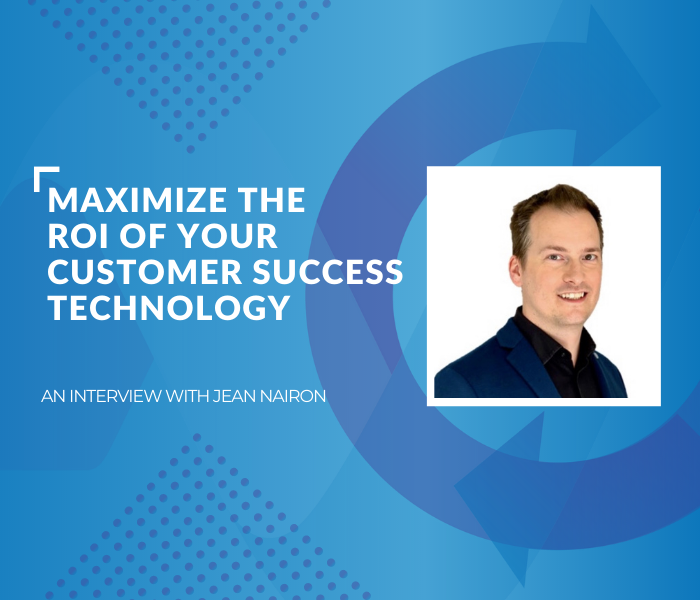Is Your Customer Success Technology Falling Short?
The Customer Success (CS) technology industry has come a long way from its humble beginnings as a reactive and largely support-based solution. As customers’ needs and expectations have grown in scale and complexity, Customer Success Technology has radically evolved to enable an organization’s CS strategy to drive value realization for the customer and vendor through revenue retention and expansion. Yet, with all its advances, Customer Success platforms have not reached the ‘must-have’ status of other enterprise software solutions like CRMs, ERPs and Marketing Automation, and many leaders are struggling to showcase the true ROI of their investments in this area due to the continued existence of legacy structures and mindset.
To remedy this, Valuize’s Founder & CEO, Ross Fulton, spoke with CS technology expert Jean Nairon. Jean has been working in Customer Success for over 15 years and has helped over 60 companies define their Customer Success strategy, optimize their operations and operationalize their infrastructure. In this interview, Jean examines the state of the CS technology market today and shares his expertise on how you can maximize your Customer Success platform investment.
Q: What would you say are the strengths of the current offerings, and their capabilities, in the Customer Success technology market?
A: “One of the biggest strengths of Customer Success technology platforms is their data model capabilities. Unlike most CRM systems, Customer Success platforms allow you to collect customer data from multiple sources across your organization and create a robust Customer 360 view. These systems are able to do this seamlessly without the problems plaguing other platforms that limit the number of records and data sources you can compile and collect. That’s a key component, and advantage, of your Customer Success platform.
The other major advantage is the ability to take action through these platforms. While there are many different tools out there that can help your teams drive your projects, emails and collaboration, it’s much easier and more efficient if all of these capabilities are centralized in one platform. Generally speaking, organizations will often assign these actions in different systems, creating unnecessary obstacles for your CS and IT teams, leading to a greater likelihood of errors. Facilitate your teams’ ability to take action and reduce their cognitive load by bringing them all into one holistic system, such as Gainsight or MetaCX.”
Q: What do you think are the key improvement opportunities for the Customer Success technology category?
A: “As it’s a relatively young technology category, there are definitely some challenges that could be addressed. I think a lot of these platforms are built with simple connectors in mind, so you can easily plug in your data and connect your CS system with your CRM system. This is great if you’re based in the cloud; however, things get more complicated if you’re in a large enterprise or you’re transitioning from an on-prem model to a subscription model – then those CS platforms are not as simple. In this case, you’re looking at enterprise legacy systems and trying to integrate these various platforms into a singular customer data model. This can be very challenging to accomplish in a Customer Success platform, as many of today’s platforms are geared towards the SaaS companies that were born in the cloud with a cloud-based tech stack. Unfortunately, that is often not the case and for companies that are transitioning from on-prem, so I’d say that’s one huge improvement opportunity for CS technology providers to capitalize on.
Another key challenge with CS technology is direct customer-vendor collaboration, which is partly a technology issue and partly a SaaS maturity issue. All business leaders are looking to drive action – we want to drive human-led and digital-led actions that enable our organizations to grow and succeed. There are definitely some companies that are thinking about it more holistically and saying; ‘I want my CSM to be really collaborative with my customer, share everything, be incredibly transparent, and I want every party to know where they’re at and how we move forward.’ Unfortunately, this level of customer-vendor collaboration is still considered a Nirvana in the CS world. We all want to get there but, because of a combination of technology that’s in its infancy and a hesitancy to share everything with the customer, we’re just not there as an industry yet.”
Q: Expanding on the concept of collaboration and looking specifically at Sales-to-CS collaboration, do you see any improvement opportunities for organizations in this area?
A: “Absolutely, and this includes bridging the gap between CRM and the Customer Success platform. Going beyond simply providing customer purchase insights, there are many valuable sources of information that should flow between these powerful systems. For instance, success plans and the desired outcomes that the customer is trying to achieve through the use of your product provides dynamic insights that are required for meaningful collaboration between various teams like Pre-Sales, Sales, Customer Success, and Professional Services. To facilitate this internal collaboration, you need the right technology. Unfortunately, the technology solutions being used in organizations today are fractured – each team has their own disparate system that focuses on their specific responsibility and you end up with various platforms that don’t connect properly.”
Q: When it comes to collaboration, an often overlooked area is partner collaboration. How do you think today’s Customer Success platforms fare when it comes to facilitating and scaling Customer Success through partner collaboration?
A: “In this specific instance, I think CRMs are ahead of the curve. Within the CRM world, you can easily share contacts, accounts and opportunities with a partner who has the same CRM platform. Conversely, in the CS technology world, there isn’t a lot of functionality for partner collaboration around accounts, such as seeing your partners’ customers, what their health scores are, what type of engagement is happening, if there’s been any NPS responses, their usage data and so on. These issues are exacerbated by privacy concerns and legalities around sharing customer data.
Once you do figure out a way to share data, you run into a host of other problems, including syncing the data across different instances and compiling the data into a single source of truth. Even something basic, like ensuring that an individual customer or record is the same across all your systems, is a monumental challenge. Because of these many issues, we still have a long way to go to facilitate strong partner collaboration through a Customer Success platform.”
Q: How do you recommend organizations approach their CS investment decisions?
A: “It depends on your organization’s maturity. If you’re an early stage startup, I recommend starting with a spreadsheet that captures your most crucial data points; what do your customers buy? What’s your customer’s health score? What’s the success plan and desired outcomes that your customers are trying to achieve? From a maturity perspective, that’s really starting at the ground level. It’s also the most cost effective option – anyone can create and maintain a Google Sheet to develop a basic understanding of their customers and use it to drive valuable action.
The next level of maturity is if you’re currently using a CRM platform, such as Salesforce. You can certainly build some functionality here to augment your CS capabilities, such as health scores and playbooks. This approach is a bit more complicated as it requires having one central data set that your cross-functional teams, including Sales, Customer Success and Professional Services, work from. While this works in the short-term, it’s important to understand that this approach isn’t scalable and will need to evolve as you grow.
If you’re considering an investment in a Customer Success platform, there are certainly some platforms that are cheaper and easier to implement, which don’t require as much total cost of ownership as some of the larger solutions available. Taking this to the next and highest level of maturity, you may be looking at one of the more advanced platforms that give you the freedom to build whatever you want, however you want. This option is definitely going to be the greatest total cost of ownership, but it’s also going to give you the most longevity and breadth in scalability. Ultimately, your organization’s level of maturity is going to determine whether you decide to build or buy and which specific solution you decide to invest in.”
Q: What are some of the core goals that organizations should focus on to make the most of their investment in a Customer Success platform?
A: “Within the CS technology domain, there are two headline functions to keep top of mind: your dataset and your ability to drive valuable actions through data.
When it comes to your dataset, you need to centralize all of the customer data that exists across your organizational ecosystem. You need to be able to answer; Are our customers using our products? What’s the customer’s response to surveys? What kind of emails are our customers receiving from our organization? What’s the customer’s subscription plan? What products have the customer bought? All of these data points form the basis of your customer data model and they all need to be collected and widely accessible in your Customer Success platform.
The second goal is figuring out how you can drive action from your customer data. Ask yourself: what are our CSMs and other customer-facing teams doing with our customers and this data? What are some of our teams’ digital actions? For example, what are the email triggers, value plans or onboarding plans that help our CSMs drive value through technology? Together, insights and action are the two core components of making the most of your investment in a Customer Success platform.”
Q: What do you see in the future for the Customer Success technology category? What are some use cases and capabilities that the industry needs to focus on and solve for?
A: “We definitely need to solve the customer value equation and figure out how to properly define Value-Based Outcomes in Pre-Sales, then take action on them in Post-Sales. Taking that one step further, we need to determine what solutions to prescribe based on the outcomes the customer wants to achieve. In many organizations, this feels more like a choose-your-own adventure situation, where you build the process out on your own based on a litany of technology solutions. At some point, we’re all going to find that we have the exact same value definition process and we’ll be able to use the same overall process to define these things in the future.
Another crucial development we’ll see in the future is the ability to share data multi-directionally. In the enterprise space, you’re dealing with a lot of systems that are updated and changed regularly. You need to make sure that the customer record and crucial assets like your value plan are up-to-date and maintained properly.”
Leverage Technology For Unparalleled Customer Value
Optimal value realization occurs when you are able to leverage your technology to operationalize and enhance every interaction your customers have with your product, content and teams across the customer lifecycle. With a centralized system for all your customer engagements, your teams can drive meaningful actions that will help your organization foster deeper relationships, drive maximum customer value realization and definitively showcase the ROI of your CS technology investment.
Listen to Jean’s full interview on the Customer Valuecast podcast for a deeper dive into the Customer Success technology domain and how you can make the most of your Customer Success platform to drive market-leading revenue retention and expansion.





